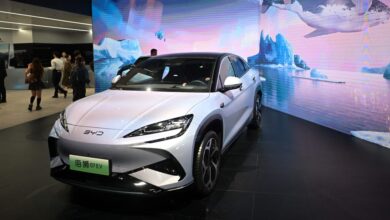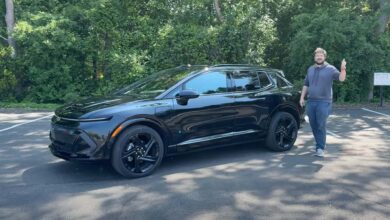Tesla doubts reach fever pitch as earnings show 9% quarterly loss for Musk-led company

Tesla has a reputation for making headlines.
But the Elon Musk-helmed electric vehicle giant is now facing some of the biggest questions in its history amid weakening sales and questions about Musk’s focus.
A growing share of investors want to know where the company is heading now that demand for all-electric vehicles is slowing, with some wondering whether Musk may be devoting more energy to other projects.
“For the first time, many longtime Tesla believers are giving up on the story and throwing in the white towel,” said Dan Ives, managing director at Wedbush Securities financial group, in a note to clients before Tesla’s first-quarter earnings were released.
On Tuesday, Tesla reported first-quarter revenues slid 9%, its steepest year-over-year drop in over a decade. While the financial results were short of Wall Street’s expectations, the stock surged in after-hours trading as the company announced plans to accelerate the launch of new models ahead of schedule — including including more affordable ones.
Amid these results, the company faces more uncertainty than at any point since its near bankruptcy several years ago. Tesla’s share price has plunged by nearly two-thirds — from about $407 at its November 2021 peak to about $145 today. The stock has held the title of the S&P 500’s worst performer this year.
Tesla remains the largest electric vehicle seller in the U.S. But overall EV sales growth has declined after a booming 2023. According to industry website InsideEVs, non-Tesla sales growth over the past 12 months climbed 18% for the first quarter — with 19 other brands selling just 102,000 all-electric vehicles altogether. That compares with a near-doubling of growth between the first quarter of 2022 and Q1 2023.
Tesla, for its part, delivered 386,810 vehicles alone in the first quarter, down 9% from the same quarter last year and falling well short of analyst expectations.
“Pessimism on the entire EV marketplace has reached very high levels,” said Mark Newton, head of technical strategy at the financial services group Fundstrat Global Advisors, LLC, in an emailed statement to NBC News.
For the average Tesla investor, the falloff has meant significant financial losses over the past couple of years.
“It’s gone from a Cinderella story to a horror show in the near-term,” Ives wrote in his note to clients.
Tesla’s biggest declines have been in China, where that country’s most successful EV automaker, BYD — which does not sell in the U.S. — has emerged as its key rival. Today, they are neck and neck for title of world’s largest EV maker.
Facing greater competition, Tesla has been slashing prices on its vehicles to buoy sales, announcing over the weekend that it would discount Models Y, X and S by $2,000 each. It also said this month it would cut 14,000 employees, or 10% of its workforce.
In the last quarter, Tesla ramped up sales of the much-anticipated Cybertruck, but it recalled nearly 4,000 of them just last week over a dangerous defect that could cause the accelerator pedal to get stuck.
As Tesla’s success has slowed, Musk’s net worth has shrunk by billions, though only enough to push him from No. 1 to No. 3 as the world’s richest person.
Some Tesla investors fear the company’s troubles are not only the result of broader EV sales trends but also because Musk has become distracted by the multiple other companies he oversees, especially the social media platform X, formerly known as Twitter.
His role in the company will be more formally examined in June, when Tesla investors will vote on whether to reinstate his $56 billion pay package after it was struck down by a Delaware judge earlier this year.
“A lot of shareholders are using it as vote of confidence for the CEO,” said Fred Lambert, a journalist who covers Tesla at EV website Electrek.
Musk has been working to shift the narrative around Tesla. He now says the company is in fact an “AI/robotics” company, even though cars still drive the bulk of its revenues. He recently posted on X that Tesla was now “going balls to the wall for autonomy,” and has placed a new emphasis on rolling out fully automated robotaxis.
Lambert said he recently drove a new version of Tesla’s automated driving technology, which is officially called Full Self-Driving (Supervised), since it still requires a driver to remain attentive to what the vehicle is doing. He said the new software represents a substantial leap forward and will further benefit from the explosive gains being made in artificial intelligence technology in the broader tech world.
“You can see a difference — it’s like night and day,” Lambert said. “It feels more natural.”
For long-term believers in Tesla — and ultimately Musk — Tuesday’s earnings report won’t change much per se, Lambert said.
“In the grand scheme of things, Tesla is not in any danger,” he said. Even for investors, Tesla is still sitting on substantial sums of cash, and it has always committed to reinvesting gains back into the company, Lambert said.
Increasingly, those investments are going toward autonomous vehicle technology. It’s not yet clear what the current consumer demand is for self-driving cars, said Tyson Jominy, vice president for data and analytics at J.D. Power.
But in a world where self-driving cars are much more popular, Tesla is positioning itself to have an enormous head start, he said.
For now, patience is running thin for a growing class of Tesla stockholders, Wedbush’s Ives said.
“The clock has struck midnight for Musk to lay out the strategic plan for the future,” he said.



